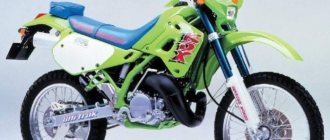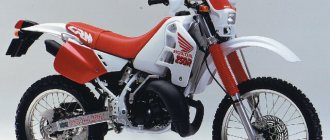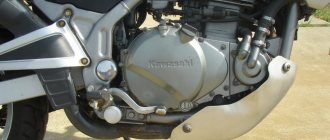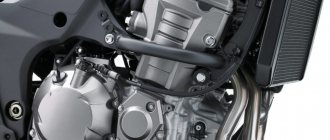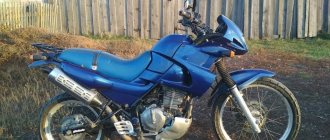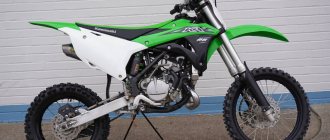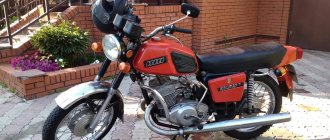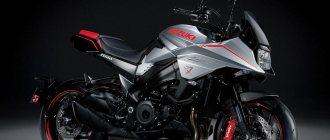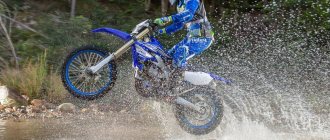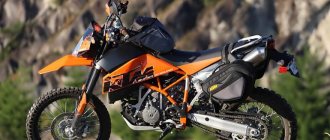| Kawasaki KDX250 (KDX250A) 1980 | Kawasaki KDX250 (KDX250B) 1981-1984 | Kawasaki KDX250 / KDX250R (KDX250E / KDX250D) 1991-1995 | Kawasaki KDX250SR (KDX250F) 1991-1994 |
Kawasaki KDX250 enduro model
begins its history in 1980, when the first generation of a motorcycle was introduced to the market, which was available only in the USA.
That generation was, by today's standards, quite archaic - 2-stroke air-cooled engine, drum brakes and crude plastics. Factory model code is KDX250-A
.
In 1981, the Kawasaki KDX250 underwent minor changes, receiving turn signals and a new plastic design. Factory model code - KDX250-B
. 1984 was the last year of production.
In 1991, Kawasaki resumed production of the KDX250, seriously updating it both externally and technically - a new liquid-cooled engine, disc brakes, and an inverted fork. Starting this year, the model became available not only in the North American market, but also in Europe, Australia and Japan. Now 3 modifications of the motorcycle were offered:
- Kawasaki KDX250R
(KDX250-D) - “hard enduro” modification. It does not have turn signals or a speedometer (it is equipped with a simple trip meter with daily and total mileage). Was available from 1991 to 1995. in Europe, North America and Japan. - Kawasaki KDX250
(KDX250-E) - identical to the previous modification, but with the possibility of use on special stages. Equipped with turn signals and a full speedometer. Existed from 1991 to 1992. in the markets of Europe and Australia. - Kawasaki KDX250SR
(KDX250-F) - “soft-enduro” modification. Was available from 1991 to 1994. only in the Japanese domestic market. It is a previous modification with a number of changes: the presence of mirrors, other suspension and geometry settings, a smaller fuel tank (from 12.5 to 11.0 l), a smaller carburetor (PWK35 instead of PWK38), other gearbox settings, dry weight increased by 9 kg .
1995 was the last year of production of the Kawasaki KDX 250, after which it finally left the market and did not receive further development.
The main competitors of the Kawasaki KDX 250 in the class:
- Honda CRM 250
- Suzuku RMX 250 S
Appearance
The Kawasaki KDX 250 looks like a typical enduro. Colors vary, but the color usually appears is green. The light green bike with a blue seat and shock absorbers looks especially impressive. The front light is small and square, like enduro and supermoto.
Spoke wheels make the bike lighter. The front wheel is slightly larger than the rear. The details are clearly visible, which gives the bike a unique effect. However, the frame covers a significant part. There are many similarities between the appearance of the KDX 250 and motocross bikes.
Model competitors on the market
The model has three main competitors. The first is the already mentioned Honda CRF 250 L, from which the model was developed. The second competitor is the Yamaha WR 250, and the third competitor is the Suzuki 250 SB. The latest model, on the contrary, is based on the Kawasaki KLX 250 SF (Kawasaki D-Tracker 250). This is not to say that the competitors are clean. Some motorcycles are more expensive, others are not as versatile as the Kawasaki. But still, the mentioned models are best suited for the role of competitors from what the market offers today.
Comfort
The motorcycle is convenient primarily for those who like to travel to places with not very good roads or without them. A tourist or, especially, a sports-tourist option is not suitable here. And enduro copes well with mud and other difficulties of wild places.
Of course, you won’t be able to take anything with you other than a backpack. But with a competent approach to motorcycle tourism, nothing else is needed. It is important that you have at least two GPS navigators with you, and that the route is thoroughly thought out. Otherwise, the bike is convenient, including maintenance and searching for spare parts.
Kawasaki KX250X 2022
Of course, there are many similarities between the Kawasaki KX250 and KX250X, but the cross-country model also received a number of discipline-specific features, including an 18-inch rear wheel, skid plate, side stand, as well as new ECU settings, a one-tooth larger rear sprocket and softer suspension (springs and valves). The differences between the Kawasaki KX250X and the base model are almost 100 percent the same as the modifications that are usually made by owners of motocross motorcycles for off-road racing, and the only thing the new model lacks from stock is lever protection.
Dimensions and weight
In terms of dimensions, this bike meets class standards. Weight, ground clearance, wheelbase - all this makes the motorcycle excellently passable and controllable in wild and difficult conditions. But we can’t say that this is a special advantage of a particular model, because most other enduros have the same dimensions.
Dimensions and weight are:
- height – 1250 mm;
- width – 850 mm;
- length – 2165 mm;
- wheelbase – 1475 mm;
- seat height – 955 mm;
- ground clearance - 340 mm;
- curb weight – 116 kg;
- Tank capacity – 12.5 l.
The fuel tank capacity will last a long time, although it is small. So it is important to make sure that you come across gas stations on time along the route, because there will be no other opportunity to refuel the tank on such a trip.
Features of the Kawasaki KLX 250 motorcycle
This model has two main modifications. The Kawasaki KLX 250 S is a classic enduro motorcycle. This modification is the most widespread. And the Kawasaki KLX 250 SF is a supermoto class (the model is equipped with road wheels, and is also equipped with a front brake of increased power and is characterized by short suspension travel). The supermoto modification is often called the Kawasaki D-tracker 250.
The motorcycle is very stylish, it is easy to control, and the pilot can get a lot of unreal emotions from riding it. With this “iron horse,” many kilometers of exciting journeys along asphalt roads and rough terrain await you. It's good on any surface!
Specifications
According to these parameters, the bike is not inferior to many others, although it is not advanced. It is important to remember the time when it was produced and make allowances when comparing with current enduro representatives. However, even today, in terms of technical characteristics, the car remains competitive with weak current models.
| Motor type | in-line, 1 cylinder, 2 stroke |
| Power | 40 hp |
| Torque | 40.2 Nm |
| Maximum speed | 180 km/h |
| Acceleration to 100 | 7.1 s |
| Fuel consumption per hundred | 7 l |
| Drive unit | chain |
| Transmission | five-speed |
| Frame | half-duplex steel |
| Rear suspension | pendulum, monoshock absorber, stroke 310 mm |
| Front suspension | inverted fork, 300 mm travel |
| Rear brakes | 1 disc, 190 mm, 1-piston caliper |
| Front brakes | 1 disc, 220 mm, 2-piston caliper |
Such parameters make this bike suitable for those who want to try off-road riding, but are wary of some powerful motocross bike. Also, connoisseurs of old representatives of the class will appreciate how the car is made and the path it has traveled.
2T 250 ENDURO BOOST and SEASON REPORT
Greetings! In this post I’ll talk about the 2t18 season on the Kawasaki KDX250 (no longer SR lol) and explain why there haven’t been any posts since installing the hydraulic clutch on the Grinch, I’ll talk about the tuners I made during the season, and I’ll also tell you about my feelings about the new character pepelatsa S:
Part 1. Motogang
This season, at my instigation, a whole mfk'n motogang was formed: the buddies bought mopeds and started breaking them))0
One bunny bought himself a well-groomed Kayo T2 at the end of the season at my suggestion for 80k: so far he has no problems.
Another bunny wanted a KTM SX-F 450 construction kit...
…
…
And of course, as possible without
The boys are already afraid of motocross 4t. Experienced mechanic aka Vano believes that the cause of the wedge is a switch from a scooter without a rev limiter, which he had to install instead of the “tuning” brains with a mode button (map 1 and map 2 - they didn’t feel the difference, they were burned by charging for the Akum). I was riding like a circus, and first the overrunning clutch jammed, and after repair *a few weeks later* the valve plate broke off when I was riding in a wheelie. Ivan spits and saves for capital.
And the third bunny took himself an Apollo RFZ140 on 17/14 wheels.
Among the problems were: a commutator that burned the coils, and a rotten front rim from which 3 spokes flew out due to a small goat in the forest. Sanchez opens his mind to new kosher aluminum cathodes)
Results:
- The Kayo T2 250 rides well, in good condition - a good alternative to the Suzuki Djebel 200 (I owned it, I know what I’m talking about): it feels quite light, rises from the gas and jerk to 2 and from bumps to 3, the plastic bends, the electric starter works. I approve.
- The KTM SX-F 450 Supermoto drives like hell, handles superbly, but eats cash. I’m still too poor for all this... It’s no fun to drive on dirt with motards - there’s so much stupidity that the gas, even on slightly universal tires, doesn’t allow it to open. There are no cross-country skating rinks. On the asphalt - cool, bazaar 0!
- Apollo RFZ 140 turned out to be a very cool pit! Nice bendable plastic, working VOLT suspension, 28/22 steering wheel, pontoon seat, thick spokes. The only thing missing is the headlights and aluminum cathodes)
Part 2. Grinch!
The Grinch has undergone some collective farming again this season)
1. The seat was covered with a cover with ali: it lay in folds, but after a few rides the folds disappeared. Now it’s gone again (I’m too lazy to re-stitch, but in general I’m planning to leave the central part and look for stronger green dermantine, it won’t work - I already know where to get high-quality black dermantine)
2. The Chinese hydraulic clutch has taken a sip! The spoke burst because it bent when pressed, it was stuck with a barrel for repairing the clutch of a Soviet motorcycle - it doesn’t bend, it runs. There was no need to pull this nut on the rod too much, but it was necessary to install 2 narrow ones and lock them with each other.
3. The direction indicators were kindly broken off by Vano along with the left mirror, the cap from the antifreeze expansion tank was lost (it came from a can of Motul)), the diode lamp burned out in his Catem, the replacement he bought turned out to be of poorer quality and also burned out. I drive with an incandescent bulb. I'm waiting for diodes that bend from Ali and mirrors with a spherical element. In the city I found only with a flat one (Not that.
4. I replaced the Chinese tires, which had been lying around in the garage for a long time, and had already worn out almost all of them in a month(
5. The fun begins now!
After driving around with the air filter soaked in blue Bloodworm for filters and reading unflattering reviews about it, I decided to try to wash it and not soak it at all: I wrung it out 1 time in water with some Dosage, 2 times in thinner - the filter is clean, but still oily! So I decided to leave it... But the spendthrift fell down! I change the GTZ from 140 to 142, take out the snorkel from the air vent box, I go, I moisten the forest with tears of happiness! I read a post in the KDX group from the happy owner of a kdx250 with 38 PWK with a CR250 that the spendthrift has become *a fool of a f*ck*, I understand that “OH ALL!” and I place orders for an enlarged intake manifold from welders in the group and for PWK 38 from Ali. After a couple of weeks I pick up the charms)
No, no, we didn’t even intend to!)
Carbs in comparison
Manifolds 34 and 44
For some incredible reason there are no photos of the installed carb. While I was installing it, I was worried that the remnants of the antifreeze tube from some kind of Zhiga were VERY difficult to stretch onto the manifold and therefore I had to first put it on the manifold, then fill it with sealant between the manifold and the reed valve, put the whole thing in place, and only then cut the rubber and insert the carb. The air resonator also BARELY got dressed with a lot of ordeals... A mandatory step is to shorten the cable jacket, since the size of the damper has increased and it no longer closes completely with the old cable. Before shoving the carb into its rightful place, I changed the GTZ from the 160 sent by the Chinese (there were no markings, I found out empirically, comparing with my own) to 165 (after all, I asked for narrow-eyed ones: idle jet - 55, main jet - 170), idle without markings, I know , which is a little more than 48, MB and 55. The next day, when I already wanted to test the result of half a day spent with this carb, it turned out that due to a loose footboard the motorcycle was falling heavily on it, and the carb was shamelessly pouring while standing on level asphalt. I had to push the carb to the right...
So, the sensations!
The moto has (oddly enough) added lows, I didn’t notice an increase in power at medium speeds, since I had a slight dullness before opening the power valves (the springs that attract the resonator burst, and the initially thin rubber bands that sealed the junction of the resonator and the cylinder became leaky). THE UPPERS ARE JUST RIPING PANTIES! The feeling is as if the top of the gears were 2 times longer. I'm happy with the tune so far, the sound has become much more serious.
Part 3. Photo-video report
I started to slowly master Sony Vegas C: I’ve only made 2 videos so far)
https://vk.cc/8virZV
https://vk.cc/8viso2
Photos from the skating rink:
Bye everyone, happy riding and tuning!
Tags
- ENDURO
- TUNING
- KAWASAKI
- KDX
History of changes
There have been few changes, but this is good, because it speaks about the quality of the bike. This means that the equipment was originally designed in such a way that almost nothing had to be modified. Those changes that have been made are more likely to be cosmetic. However, these are also important to note.
Here's the evolution of the Kawasaki KDX 250:
- In 1981 there was a restyling. Since then, the model is already considered the second generation.
- In 1991, the third generation saw the light. There was a new restyling, and a couple of modifications arose.
- In 1995, the last year of production, all modifications were no longer offered.
The fact that production stopped is natural given the development of technology. Updating an enduro, sport bike or even road motorcycles to a modern, up-to-date state is not easy, because it is much cheaper and more expedient to release a new motorcycle from scratch that keeps up with modern times.
Conclusion
The Kawasaki KLX 250 is a great motorcycle for beginners. No claims to leadership in its class. It's a little weak off-road, but very good in the city. This is the model that is universal. This bike will teach you the basics. And you will understand for yourself: where you should move next, and also decide which motorcycle to choose next for yourself.
Some low power of the motorcycle is not only its disadvantage, but also its advantage. It is lightweight and maneuverable. In these indicators, it looks more profitable than most of its competitors. Another advantage of this bike is its relatively low market value.
What do the owners say?
The motorcycle is reliable, which is clear from the photos and videos. Most owners agree with this. However, someone notes that among all the enduros he has tried, this is not the most reliable.
According to the descriptions of those who have been traveling this way for a long time, the bike usually does not fail, but they still do not advise traveling far from civilization.
Judging by the reviews, it is possible to get good used equipment, but it is important to carefully read the documents. It is advisable to apply all modern methods of checking the condition of the bike to make sure that the machine is well preserved. If the equipment looks good on the outside, this does not mean anything.
Also, one review or another notes that this motorcycle is easy to buy. About 100 thousand Russian rubles – that’s how much such a model costs. The car is praised for its handling and ease of use, but few people called this option the best in the enduro class.
In conclusion, the Kawasaki KDX 250 is the choice for those who want to travel alone and without luggage. The bike is reliable and comfortable, although the best results at the end of the twentieth century were, of course, achieved by Honda. In any case, the machine from Kawasaki is not bad and is still capable of competing with current models.
Reviews
Reviews about Kawasaki KDX 250:
Expand Collapse
Normal device. I had an '89 KDX 200SR. Very smooth thrust for 2T, due to power valves at the exhaust. It's great at the top too! The frame and chassis are in principle indestructible; everything worked on the 1989 vehicle. “SR” is a domestic Japanese model; it is distinguished by the presence of a separate lubrication system, tidy, normal lighting and turn signals. So just what you need. It is possible both on shit roads and on public roads. I myself used it for “dacha racing”. Among the problem areas, these same power valves periodically become clogged with carbon deposits and stop working. In general, sometimes they require maintenance. Models after '94 are less susceptible to this problem. When purchasing, you should pay special attention to the piston! Because These bikes, as a rule, are far from new. And the boiler is made of aluminum with nikasil, which, although reliable, does not last forever. It cannot be repaired; in principle, you can buy a new boiler, but it costs as much as a cast-iron bridge! I don’t remember any other weak points...
